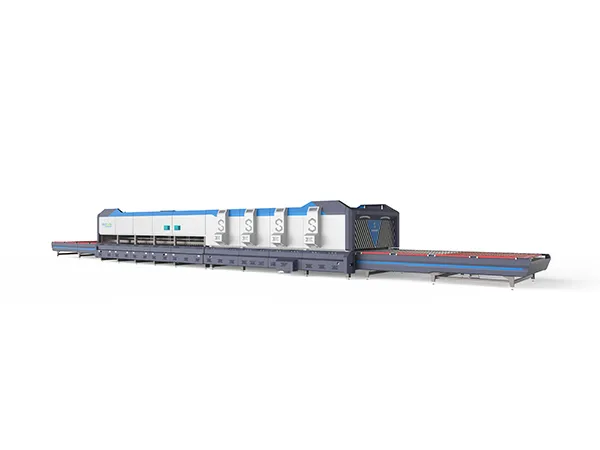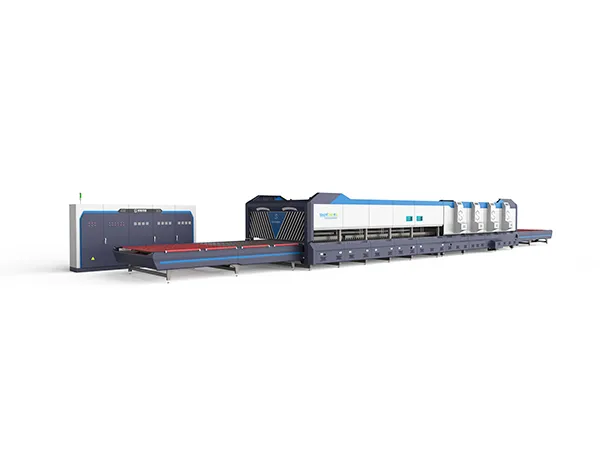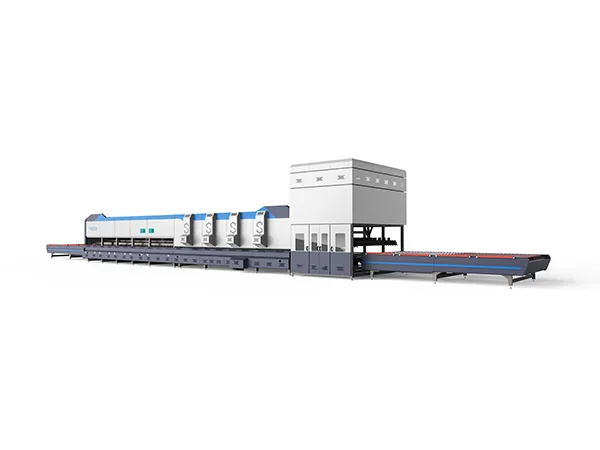Tempering furnace convection is an important heating and cooling method in glass tempering furnaces. It mainly transfers heat through the flow of liquid or gas to achieve rapid heating and uniform cooling of glass, thereby improving the strength and durability of glass. The correct use of tempering furnace convection is crucial to ensure the quality and performance of tempered glass.
Tempering furnace convection

1. Tempering furnace convection form
In glass tempering furnaces, there are two main forms of convection: natural convection and forced convection:
Natural convection: Natural convection refers to the phenomenon of spontaneous flow of liquid or gas formed due to temperature difference inside the glass tempering furnace. Hot liquid or gas becomes lighter due to heating and rises to the colder area, while cold liquid or gas sinks to the heated area, forming a circulating flow. This form of convection is relatively common in glass tempering furnaces, especially during the heating and cooling stages. Through natural convection, the temperature distribution on the surface and inside of the glass is more uniform, which helps to reduce the internal stress of the glass and improve the tempering effect.
Forced convection: Forced convection is a form of convection achieved by forcing flow through external equipment such as fans, circulating water pumps, etc. In glass tempering furnaces, forced convection is usually used in the heating stage, and the air in the furnace is forced to circulate through the fan, so that the glass is heated more evenly. This helps to reduce temperature differences, improve the heating efficiency of the glass, and ensure that the entire glass surface obtains a uniform temperature distribution. Forced convection also speeds up the cooling process, increasing the strength and impact resistance of the glass.
2. The role of convection in tempering furnaces
Promote uniform temperature distribution: Heating and cooling by convection can make the temperature inside the glass evenly distributed, avoid overheating or local low temperature, and thus ensure the quality and performance of the glass.
Improve heating efficiency: Forced convection can speed up the heating speed of the glass surface, so that the glass can reach the required temperature in a short time, and improve production efficiency.
Enhance the tempering effect: Uniform temperature distribution and rapid cooling process help to create a uniform pressure difference on the surface and inside of the glass, thereby increasing the strength and durability of the glass.
3. Correct use of tempering furnace convection

Accurately set parameters
Accurately set the parameters of the tempering furnace according to the type, thickness, shape, etc. of the glass. This includes temperature, heating time, cooling time, etc. to ensure that the processed glass fully meets the quality requirements.
Pay special attention to check whether there are scratches or damage on the surface of the glass, and whether there are cracks in the internal structure of the glass.
Accurately place the glass
Before placing it in the tempering furnace, ensure that the glass is placed accurately and stably, and that the surface of the glass is in smooth contact with the fixture.
Strictly control the heating temperature
The tempering furnace uses a heating head to heat the glass directly. The heating temperature must be strictly controlled, generally around 600℃.
If the temperature needs to be changed, appropriate measurements and adjustments should be made before heating to ensure that the temperature is evenly distributed.
Reasonably set the convection system
During the heating stage, use forced convection to quickly and evenly heat the glass surface. This is usually achieved by adjusting the speed and direction of the fan and blower.
The fan setting should ensure that the airflow circulates evenly inside the tempering furnace, thereby ensuring that the tempered glass is heated evenly.
According to the glass material and process requirements, set the temperature and wind speed, as well as the appropriate upper and lower temperature difference, so that the temperature distribution in the furnace is uniform.
Use rapid cooling technology
The heated glass needs to be quickly cooled by methods such as warm immersion and wind quenching to be fully tempered.
During the cooling stage, the convection speed also needs to be accurately adjusted to avoid problems such as glass breakage caused by excessive cooling.
Check the tempered glass
After the tempering furnace is processed, the tempered glass is inspected. Mainly check the flatness, uniformity of quality and appearance defects, so that timely repairs and adjustments can be made.

4. Application fields
Tempering furnace convection technology is widely used in the field of glass deep processing, such as the tempering of high-quality glass such as solar glass, building curtain walls, home appliances, furniture, and automobiles. These fields have high requirements for the strength and durability of glass, and tempering furnace convection technology can meet these requirements and produce tempered glass products with higher quality and better performance.
In summary, the correct use of tempering furnace convection involves many aspects, including accurate parameter setting, reasonable glass placement, strict control of heating temperature, reasonable setting of convection system, use of rapid cooling technology, and regular maintenance and care. Through the implementation of these measures, the quality and performance of tempered glass can be ensured to be optimal.










